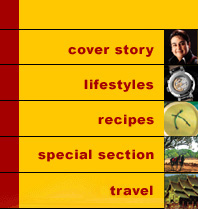


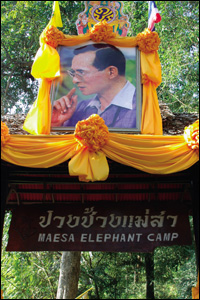
Elephants Ahoy! At the Maesa Elephant Camp in Chiang Mai you learn how gentle and docile, this giant of an animal is. Also how intelligent and talented he can be. �It�s amazing�, says Farzana Contractor I was rather excited at the prospect of visiting an elephant �farm�. I had heard there were hordes of them at the Maesa Elephant Camp and that apart from giving rides they entertained you with the special skills they possessed. Settling down to some breakfast at the simple Caf� at the Maesa Camp, with Choo Chart Kulmapijithe Jr., the young proprietor, I learnt the Thai people have always had a special place in their hearts for elephants. So drawn are they to elephants that they even have a study dedicated solely to elephants. And this local wisdom has been passed down from generation to generation to help train elephants, communicate with them, care for them and build that special bond between the animal and the mahout, his caretaker. The art of elephant training is not easy and requires patience and endurance, not to speak of love and consideration between each elephant and its mahout. Choo informs me they have 78 elephants at the camp presently. His father started the business in 1976. When asked why he thought of starting an elephant camp he merely smiled and said, "Elephants are sacred to us, that�s why". It had never occurred to me to learn more about elephants earlier and it surprised me to know that a pregnant elephant carries the baby for 22 months before it is born! In any case it is very difficult to tell when an elephant is pregnant, even the vet remains clueless for a long time. Well, that�s nature. But once the baby is born it stays with the mother for two years. In case you are interested in other �elephantrivia�, the average life span is very much like that of human beings, 80 years and they prefer one mahout to stay with them all their lives. And how much does an elephant cost? Anywhere from 100,000 to a million bahts. So what�s a day in the life of a Maesa elephant? To begin with they work an eight hour shift, between 7am and 3 pm, which is visiting hours for the public. After that the elephants rest, or sleep, which they do lying down on their sides, strangely they need just four hours of good sleep. The foodie that I am, I was most interested in knowing what an elephant ate. Grass, 200 kgs of it, everyday. And to feed all of them, 6 tonnes is the daily requirement. Phew. And bananas and sugarcane are desserts. In limited quantities, since there is a danger they can get diabetes. But as I stood watching them eat bananas, I saw how crazy they were about the fruit. That�s what the tourists buy and offer them. One almost yanked a whole bunch from my hand, almost sweeping me off my feet. Show time was a treat. Its amazing the feats they have mastered. Most of them can dance, some play the mouth organ, others football- and pretty well too. The show I saw had a terrific goalkeeper! They play darts, burst balloons, push logs, and even paint. Elephant art in its element. Choo and family have held exhibitions, in the country and overseas, sold their art, a large one for as much as 1.5 million bahts. I got one for myself, it�s an elephant by an elephant. My 10 year old baby was sweet, after the walk, Kong Kump sat down and offered me his lap, and posing so we shot a picture, for posterity. Hope you saw it, it�s on the editorial page. PHOTOGRAPHS BY FARZANA CONTRACTOR |
|
|

Home Page
About the mag
Subscribe
Advertise
Contact Us

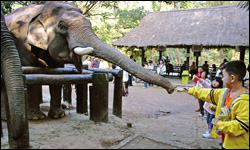 Whether they worked together to log timber, travel across harsh terrain, or lead troops into battle, they have had a close relationship with elephants down the centuries.
Whether they worked together to log timber, travel across harsh terrain, or lead troops into battle, they have had a close relationship with elephants down the centuries.
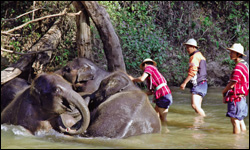 They started with just three or four elephants and added on as they went along. Twenty babies have been born on the camp, the oldest is 42 years old.
They started with just three or four elephants and added on as they went along. Twenty babies have been born on the camp, the oldest is 42 years old.
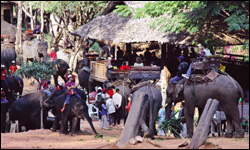 During this time, the elephants perform and entertain, paint, take people for joy rides, have their bath - which means their mahouts give them a good, strong scrub in the river on the property.
During this time, the elephants perform and entertain, paint, take people for joy rides, have their bath - which means their mahouts give them a good, strong scrub in the river on the property.
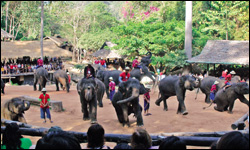 And their bedrooms are called garages! They should get a bit more creative about that term!
And their bedrooms are called garages! They should get a bit more creative about that term!
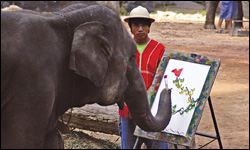 Some day my Paya might fetch me a million bucks, who knows. Incidently the artist was just 5 years old. The memory that will be etched in my mind is my very personal interaction with Kong Kump, a baby elephant. I first learnt a few words and then managed to climb up it�s back, all on my own. You first clutch its ear, then the skin on his left shoulder, when you do that the elephant puts his foot up, then you loudly say sung, which means, put me up and heave yourself up! It�s not exactly easy. You have to have long legs and an even longer swing. I got the hang of it though, and then elephant talked him into taking me for a walk, pai - go! Sai, kwa, left, right, now stop - how. When you want to get off you say hup, and kick on its leg.
Some day my Paya might fetch me a million bucks, who knows. Incidently the artist was just 5 years old. The memory that will be etched in my mind is my very personal interaction with Kong Kump, a baby elephant. I first learnt a few words and then managed to climb up it�s back, all on my own. You first clutch its ear, then the skin on his left shoulder, when you do that the elephant puts his foot up, then you loudly say sung, which means, put me up and heave yourself up! It�s not exactly easy. You have to have long legs and an even longer swing. I got the hang of it though, and then elephant talked him into taking me for a walk, pai - go! Sai, kwa, left, right, now stop - how. When you want to get off you say hup, and kick on its leg.